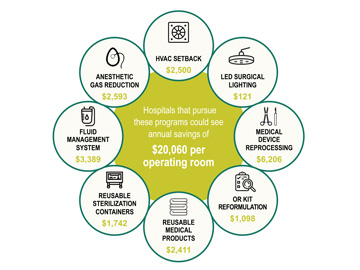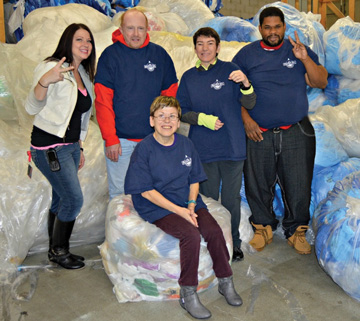• Custom packs. Look at opportunities to reduce waste through your procurement practices, including reviewing your custom packs, says Ms. Sheehan. Often, items in those packs are routinely thrown away because they’re not needed.
That’s an added cost upfront and it adds to disposal expenses. Ms. Sheehan recommends that a surgeon, nurse or other clinical staffer perform an inventory analysis to eliminate routinely unused items, or items that typically go past
their expiration dates, and have your vendors remove them from future packs.
• Rigid sterilization containers. Eliminating as much blue wrap as possible should be the goal.
“OR nurses often tell me, ‘What do we do with all this blue wrap? It’s everywhere!’” says Ms. Sheehan. “Rigid containers reduce blue-wrap usage.”
Many centers have also taken to turning blue wrap into garments and sleeping materials for homeless populations. In addition to Regions Hospital’s use of reusable containers — over 75% of its facility’s instrument sets are in
them now, estimates Ms. Pepin — its health system’s green team has contracted with a company that makes reusable shopping bags out of its blue wrap.
Additionally, Ms. Sheehan says some vendors even accept blue wrap for recycling, because it’s a polypropylene number five plastic, and turn it into little pellets used to construct park benches, building material blocks and more.
• Reusable instruments. The sterilization process uses chemicals such as ethylene oxide, which are problematic for the environment, points out Ms. Sheehan. “But we’re trying to get away from single-use disposables because
of their impacts in natural resource extraction, manufacturing and disposal,” she says.
Ms. Sheehan notes that it’s possible to sterilize and reuse single-use items. “We advocate for reusables, first and foremost, but if you’re going to use a single-use disposable instrument, reprocessing it through an FDA approved
third-party reprocessor has a place,” she says.
• Environmentally friendly anesthesia. Low flows of anesthetic gases that produce the least environmental burden possible are an easily achieved, low-impact goal. “Nitrous oxide and desflurane have high global warming potential
in terms of their emissions, and desflurane is the most expensive anesthetic gas in health care,” says Ms. Sheehan. “Using an alternative such as sevoflurane or isoflurane is a great strategy. Because gases are mostly unmetabolized
by the patient, you don’t need to use high flow rates throughout a whole case. It’s another scenario where more isn’t necessarily better.”
• Fluid management. The goal should be to eliminate single-use disposable canisters. “Direct-to-drain systems are great investments, and a couple are designed specifically with ASCs in mind,” says Ms. Sheehan. “They’re
smaller and hardwired into the plumbing.” As a bonus, these systems minimize exposure to blood and bodily fluids for staff, and several options can also provide surgical smoke evacuation to enhance the safety of OR staff and patients.
• Waste segregation. While not flashy, Ms. Sheehan says this basic step can significantly reduce your environmental footprint, provided staff complies and everyone breaks old habits. Make sure recycling receptacles are placed in strategic
locations throughout the facility, focusing on areas where staff dispose of recyclable items. “Staff are prone to fill up the closest waste bin,” she says. “Conduct proper education and hang signage near recycling receptacles
to ensure materials that can be recycled are recycled.”
At Ms. Pepin’s facility, recyclable materials in the OR often ended up in general trash bins. Housekeeping now supplies one or two tall blue recycling bins for every suite. “We recycle paper, clean plastics such as water or saline
bottles, and acceptable rigid packaging,” she says. “At the end of every case, it’s all taken and put into another area where we collect all recyclables, and housekeeping takes it down and puts it in the proper receptacles
for collection.”
Ms. Pepin says exactly what can be recycled at any given time can be a moving target, making a strong relationship with your waste management vendor important. “We used to recycle more plastics than we are now, but we still do a fair amount,”
she says. “Our contracted waste management company constantly tells us which plastics we can recycle and which we can’t.”
Asking for input from staff about these strategies is important because you might get pushback on any number of them, according to Ms. Sheehan. “Getting a couple wins under your belt to begin can be powerful,” she says. “Having
a green team and leadership structure in place to solicit ideas and get support involving key stakeholders is really important.”
.svg?sfvrsn=be606e78_3)


.svg?sfvrsn=56b2f850_5)